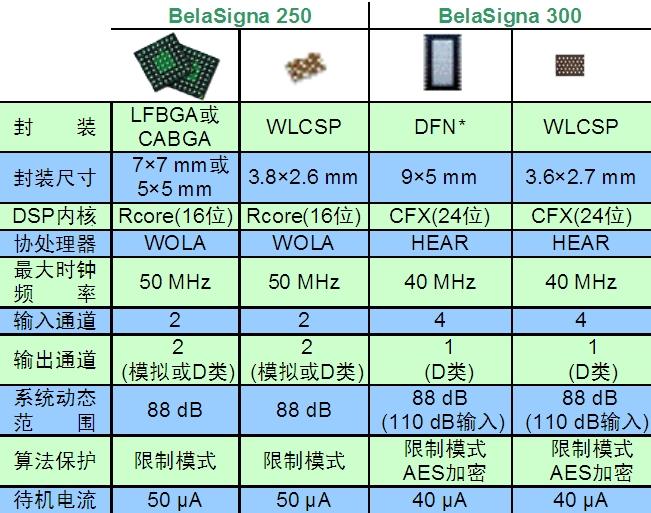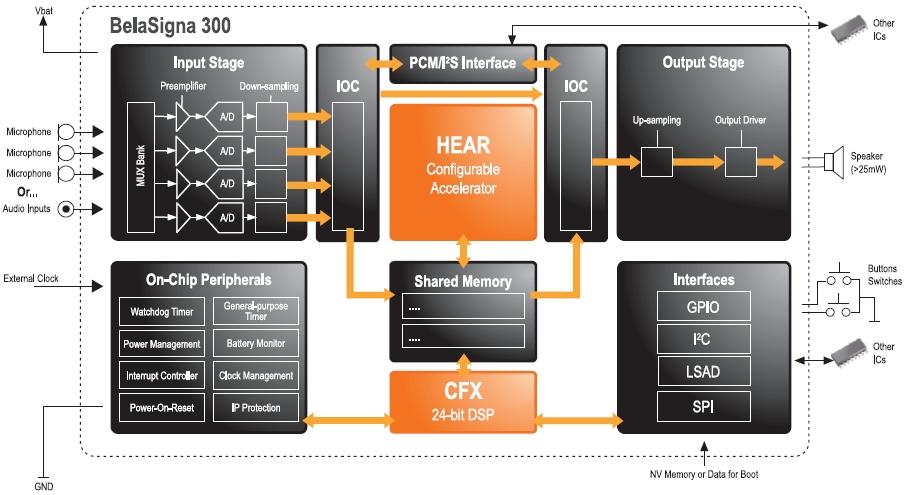Consumers who use mobile phones, wireless headsets, and portable communication devices such as laptops with integrated webcam microphones and voice over IP (VoIP) accessories are required to be able to speak loudly and hear each other in noisy environments, and Echo interference.
This article refers to the address: http://
There are many factors affecting audio effects, such as signal-to-noise ratio, dynamic range, distortion, and transient response. Dynamic range is a fairly critical technical indicator. If the dynamic range is too narrow, the overall audio performance will be equivalent. limited. In terms of call noise, a typical example is when talking on a mobile phone in a car, the device captures continuous and dynamic background noise, such as wind noise, ground noise or engine noise, in addition to the user's own sound. Causes serious interference to the other party to the call.
In addition, as portable devices become smaller and smaller, the position of the microphone and the speaker are getting closer and closer, and the mobile phone user may face the dilemma of the voice that is transmitted to the other party and transmitted back by the other party's microphone to hear the echo.
These factors affecting the consumer's audio experience require manufacturers and system designers to integrate more advanced audio processing functions, including hardware and software, into portable communication devices, making voice calls in noisy environments even louder. Be heard clearly, and eliminate echoes. This has led to the pursuit of high-fidelity (Hi-Fi) audio processing solutions are more popular with consumers.
These requirements present challenges for designers because they typically must be completed in a smaller form factor and design constraints that do not affect power consumption (battery life), weight (battery size), and cost (especially sensitive to consumer equipment).
Advanced BelaSigna® 300 audio processing solution delivers Hi-Fi audio quality As the world's leading provider of high performance, energy efficient silicon solutions, ON Semiconductor's BelaSigna® audio processing solutions such as BelaSigna® 250 and BelaSigna® 300, Just providing more advanced audio processing hardware and software for portable systems allows designers to apply complex audio processing techniques without sacrificing battery life or increasing battery size.

Table 1: Main Indicators of ON Semiconductor's BelaSigna® Series Audio Processors
The new BelaSigna® 300 is a 24-bit ultra-low power Hi-Fi audio processor measuring just 3.6 x 2.6 mm. It provides a general purpose digital signal processor (DSP) with the power and size of a fixed-function application-specific integrated circuit (ASIC). Flexibility, added advanced analog audio input and 24-bit signal path for superior audio quality, unique patented dual-core architecture for simultaneous operation of many advanced audio algorithms such as echo cancellation and noise reduction, and lower power consumption, suitable for Portable communication device applications such as mobile phones and wireless headsets. Figure 1 is a functional block diagram of the BelaSigna® 300. A brief analysis of each functional module is as follows:
Figure 1: Functional block diagram of ON Semiconductor's BelaSigna® 300 audio processor

Input Stage: Provides signal selection, signal amplification, anti-alias filtering, analog-to-digital conversion (ADC), and sample rate decimation power. Supports multiple microphone and line-level audio input signals. Four independent Sigma-Delta ADCs can be used simultaneously. It also combines two of the ADCs into one input channel, resulting in a dynamic range of up to 110 dB.
Input Output Controller (IOC): Advanced Direct Memory Access (DMA) processors are custom designed to manage audio signal movement without the need to load any DSP core (HEAR or CFX). The intelligent access mechanism ensures that only minimal address algorithms are required, simplifying the programming of the overall system.
On-chip Peripheral: A powerful power management module that handles a variety of battery or power conditions; a clock generation and management module that provides optimized computational efficiency/power ratios; and an IP protection module that prevents unauthorized software access. Timers and other system monitoring modules are used to further simplify system programming.
HEAR Configurable Accelerator: Performs ultra-efficient low latency, high fidelity (Hi-Fi) filter banks and vector processing operations. Filtering can work in both time and frequency, and can be set in uniform or non-uniform bands. The HEAR accelerator's functional chain is highly configurable with dedicated software tools.
CFX DSP Core: This fully programmable 24-bit dual MAC DSP core is the primary digital processor used to configure the system and coordinate signal data streams. Includes a set of instructions that enable the functionality of a microcontroller (MCU).
Output Stage: Provides up-sampling to directly drive the speaker to provide the appropriate output power for the earphone and the earphone; a separate DC decoupling filter ensures that even at the highest output power The lowest distortion.
Interface: Supports GPIO, I2C, LSAD, PCM/I2S, UART, and SPI interfaces to ensure seamless connection to other systems and typical Human Machine Interface (MMI) devices such as buttons, potentiometers, and light-emitting diodes (LEDs).
Figure 2: Circuit diagram of the BelaSigna® 300 Hi-Fi audio processor in mobile phones and speakerphones

Figure 2 shows an example of the application of the BelaSigna® 300 audio processor in mobile phones and speakerphones. It should be noted that the speaker function in the figure can be integrated into the earphone speaker, but it remains external in the high-power speakerphone.
Different algorithm software and hardware complement each other to meet differentiated requirements In addition to providing the hardware of the BelaSigna® family of audio processors, ON Semiconductor also offers embedded software and hardware including advanced echo cancellation algorithms, noise reduction and other audio enhancement algorithms. Complement each other for designers to choose. These embedded software covers algorithm solutions from third-party partners such as ON Semiconductor, ExAudio, 2Pi, dlab, SRS Labs, and Alango, customer-developed algorithms, and custom algorithms developed by ON Semiconductor for application requirements. In addition, ON Semiconductor offers a variety of development support, such as technical support and training, engineering and design services, reference designs, and evaluation and development tools (such as hardware reference tools, DSP development tools, and communication tools) to facilitate application design.
In the case of BelaSigna® 300, ON Semiconductor offers or plans to offer a variety of bundled algorithm software to meet the differentiated needs of customers. These bundles include:
ï¬ LP-AEC (using AEC and SNE algorithms for hands-free phones and mobile phones)
ï¬ Noise reduction (using SNE algorithm for portable communication devices)
ï¬ TX bundle software (using dual microphone and AEC algorithm for mobile phones and laptops)
ï¬ RX bundle software (using SNE, EQ, AAE algorithms for mobile phones and mobile phone accessories)
ï¬ â€œIntegrated package†(including RX bundled software and TX bundled software supporting AEC and SNE algorithms for mobile phones and communication devices)
Summary Consumers are increasingly demanding audio quality for portable communication devices and require longer battery life. This has driven manufacturers and system designers to use advanced low-power audio processing techniques in portable communication devices for better noise reduction and echo cancellation, providing higher audio reproduction. ON Semiconductor's Hi-Fi-enabled BelaSigna® 300 audio processor features a patented dual-core architecture that provides DSP flexibility in ASIC power and size, supporting advanced noise reduction, echo cancellation and audio enhancement algorithms. Extremely high dynamic range, taking up very little board space, and typical power consumption is extremely low, only needed
1~10 mW, ideal for portable communication device applications such as mobile phones and wireless headsets. To meet the needs of possible differentiation and to facilitate the development of portable system designers, ON Semiconductor also offers a rich bundle of algorithm software packages, reference designs and evaluation and development tools to help them reduce development time and speed time to market.
Control Cable ,Cable Control ,Push Pull Control Cable ,Instrument Cables
Electric Wire & Cable Co., Ltd. , http://www.nbpowercable.com
